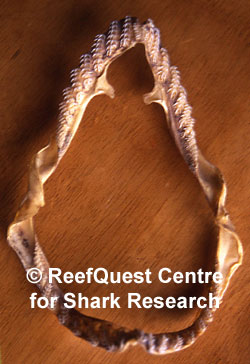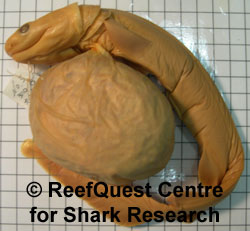Deep Sea: the Twilight Zone and Beyond
Frilled Shark
Thought by some cryptozoologists to be responsible for certain ‘sea serpent’ sightings, the eel-like Frilled Shark (Chlamydoselachus anguineus) certainly looks the part. Featuring a strange lizard-like head, ruffled throat, long, serpentine body and tiny fins, this strange shark might well explain many reports of sea serpents were it not for two inconvenient facts: it rarely grows longer than about 6.5 feet (2 metres) and almost never visits the surface. But recent research is revealing that the Frilled Shark is a fascinating creature in its own right, every bit as wondrous as any imaginary beast.
Just the Facts:
Size:
Reproduction:
Diet:
Habitat: Deep Sea Depth: 165-4,200 ft (50-1,280 m) Distribution: Arctic, Tropical Eastern Pacific, Chilean, Caribbean, Eastern North Atlantic/Mediterranean, West African, Southern African, South East Asian, Southeast Australian/New Zealand, Japanese |
Named for its six pairs of collar-like gills with frilly edges, the Frilled Shark combines many unusual features. Unique among sharks, the Frilled has its first gill slit continuous across the throat. Its long jaws are terminal (at the end of the head, rather than underneath as in most sharks) and armed with some 300 trident-shaped teeth arranged in about 25 rows. The skeleton is deceptively simple and poorly calcified, probably an evolutionary response to its nutrient-poor deep-sea habitat. Its body is elongate with a low dermal ridge along each side of the belly. The pectoral fins are relatively small, there is only a single dorsal fin, the caudal fin is continuous with the long axis of the body and it has only the merest hint of a lower lobe. Lastly, the pelvic, dorsal and anal fins are located far posterior on the body, resembling the flights (wings) on a throwing dart.
Known from scattered marine locations around the globe, most Frilled Shark specimens have come from Japanese waters. The majority of captures are thought to be from near the bottom, at depths of 400 to 4,200 feet (120 to 1,280 metres), but these may be an artifact of the method of capture: with deep-sea longlines and bottom gill nets, it is often impossible to determine whether a capture was made at the set depth, on the way down, or on the way back up. Recent evidence from stomach contents suggests that the Frilled Shark sometimes makes forays far from the bottom into midwater.
Based on its body shape, it has long been assumed that the Frilled Shark swims by employing an eel-like wriggle. But its body cavity is elongate and packed with a huge liver perfused with low-density oils and hydrocarbons, making the Shark almost neutrally buoyant at depth. This fact, combined with the posterior arrangement of most of its fins suggests that the Frilled Shark may hover in midwater and — using its posterior fins as propulsive surfaces — strike, snake-like at its prey.
 |
At depths between 160 to 660 feet (50 to 200 metres) in Saruga Bay, Japan, Frilled Sharks eat mostly squids. A recent study revealed that they eat not only weak-swimming deep-sea squids but also some surprisingly fast and powerful mesopelagic varieties. Although the study found that cephalopods compose about 61 percent of Frilled Shark diet, it also showed that a further 11 percent is composed of various teleost fishes. While the squids could be identified, often to species, based on their chitinous beaks, teleost prey was in a state of digestion too advanced to allow identification to species or even family. There is also a report of a 5.3-foot (1.6-metre) Frilled Shark from coastal waters off Choshi, Japan, that had in its stomach a 21-ounce (590-gram) Japanese Catshark (Apristuris japonicus). Thus, Frilled Sharks capture prey near the bottom as well as far above it. |
No one has ever seen a Frilled Shark actually feeding, so we have no idea how they find or capture prey. Unlike most sharks, the Frilled has extending along its flanks an ‘open’ lateral line, possibly making this vibration-detecting system sensitive to even the tiniest movement. The Frilled Shark’s large mouth and treble hook-like dentition are well suited to snagging smooth, soft-bodied cephalopod prey and I suspect that its specialized gill slits help by creating a partial pharyngeal vacuum to suck in the weaker swimming species. But, like most aspects of Frilled Shark life, how this species feeds is an almost complete mystery.
 One aspect of Frilled Shark biology that recently became a little less
mysterious is reproduction. A study of 264 Frilled Sharks from Saruga Bay,
Japan, found that here this species breeds year-round, producing an
average litter of 6 pups, each about 22 inches (55 centimetres) long. It
is hardly surprising that Frilled Shark litters are typically rather
small, given this species slender build. In fact, the female Frilled Shark
has a trunk proportionately longer than that of the male, presumably to
make room for developing young in a remarkably attenuate body. But what is
downright astonishing is the duration of the gestation period, estimated
to be as much as 42 months (3.5 years). If this is correct, the gestation
period of the Frilled Shark is nearly twice as long as that of an African
Elephant (22 months) and by far the longest of any vertebrate animal.
One aspect of Frilled Shark biology that recently became a little less
mysterious is reproduction. A study of 264 Frilled Sharks from Saruga Bay,
Japan, found that here this species breeds year-round, producing an
average litter of 6 pups, each about 22 inches (55 centimetres) long. It
is hardly surprising that Frilled Shark litters are typically rather
small, given this species slender build. In fact, the female Frilled Shark
has a trunk proportionately longer than that of the male, presumably to
make room for developing young in a remarkably attenuate body. But what is
downright astonishing is the duration of the gestation period, estimated
to be as much as 42 months (3.5 years). If this is correct, the gestation
period of the Frilled Shark is nearly twice as long as that of an African
Elephant (22 months) and by far the longest of any vertebrate animal.
Life proceeds very slowly in the deep-sea, and it appears that the Frilled Shark’s breeding cycle is no exception. The intense cold of its deep-sea habitat slows the metabolic processes of the Frilled Shark to a glacial creep. Thus, the secret and mysterious life of this real-life ‘sea serpent’ is fundamentally alien to our own lives, hurriedly taking place in the warm sunshine far above.
